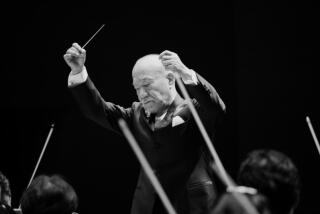Koto a Standout in Akiyoshi Suites
- Share via
In a preconcert lecture Friday night before the world premiere of her “Suite for Koto and Jazz Orchestra” at the Veterans Wadsworth Theater, composer Toshiko Akiyoshi told the audience, “I just can’t hear a koto player playing bebop.”
The statement explained why Miya Masaoka’s koto, the traditional Japanese stringed instrument, stood determinedly apart in both rhythm and spirit from Akiyoshi’s 18-piece ensemble during the suite’s three movements. Heard mostly with the band at full rest, Masaoka’s contributions contrasted sharply with the mood and tempo of the walk, bop and swing that it bracketed.
Akiyoshi, long known for employing Eastern influences in her jazz charts, demonstrated the wisdom in keeping the koto in its own world. The first movement, with a now-discarded title of “Temple in Urban Square” used the jazz band to suggest a hectic modern city centered on an ages-old cultural center portrayed by the koto. The band’s bustle, amplified by Lew Tabackin’s breathy flute tones and Akiyoshi’s own crowded harmonies at the piano, gave way to silence as Masaoka sounded respectful themes.
Even as the koto became more involved in the second and third movements, its role remained shadowy as it added a single pulsing note behind the swelling orchestra or responded to Tabackin’s flute. Only in the final movement, did Masaoka (who has collaborated with Ornette Coleman, Pharoah Sanders and others) transcend the role of her instrument, creating sonic effects, blues notes and off-beat progressions worthy of experimental music. But even this she did alone, with the orchestra silent.
Though one might have hoped for more integration between the featured instrument and the band, the wisdom of this separation was apparent. Unlike the music of fusion band Hiroshima, in which the koto loses its identity, Akiyoshi’s piece used the koto to create traditional tones and moods that contrasted magically with the band.
A second suite, “4 Seasons of Morita Village” which used prerecorded tapes of Japanese music and chants, showcased Akiyoshi’s ability to make a visual impressions with her music, spurred by her explanations of what inspired them. The piece highlighted the flute and tenor play of saxophonist Tabackin, who like Masaoka in the koto suite, was given ample unaccompanied time to make provocative statements.
More to Read
The biggest entertainment stories
Get our big stories about Hollywood, film, television, music, arts, culture and more right in your inbox as soon as they publish.
You may occasionally receive promotional content from the Los Angeles Times.










